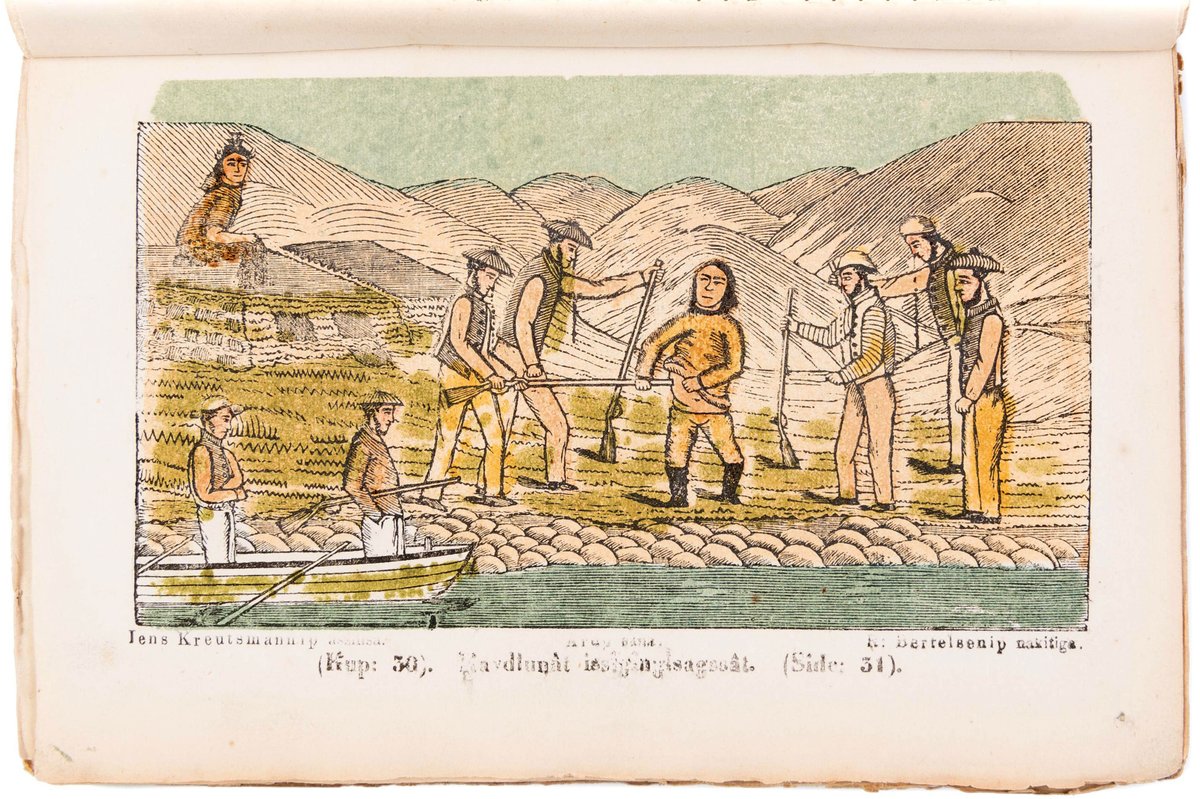
Kaladlit Okalluktualliait - edited by Hinrich Rink & printed by Lars Møller at Godthåb in Greenland in 1859-63.
These 4 volumes of Greenlandic folktales, illustrated with remarkable woodcuts by an Inuit artist, are amongst the rarest & most extraordinary of exotic imprints. 1/

These 4 volumes of Greenlandic folktales, illustrated with remarkable woodcuts by an Inuit artist, are amongst the rarest & most extraordinary of exotic imprints. 1/


The text is in both Danish & the Kalaallisut dialect of the Greenlandic language. In the first two vols the illustrations - 30 woodcuts - were supplied by an Inuk named Aron of Kangeq, a sealer & walrus hunter who lived at the Moravian mission at the trading station of Kangeq. 2/ 



This set has the ex-libris of the great Anglo-Danish collector Bent Juel-Jensen, who wrote: "this is far and away the biggest and the most important undertaking of the little early press at Godthaab, Greenland. Its importance rests on the Greenlandic tales which otherwise... 3/ 

... might have been lost with 'civilization'. It's the magnum opus of that extraordinary artist Aron Kangek, the hunter who without formal training with simple tools cut the marvellous woodcuts. The acquisition of this was one of the greatest thrills I've had as a collector." 4/ 





This series of folktales is, according to Oldendow, "probably the first text printed by Native American people preserving their own cultural heritage. It represents the earliest [printed] expression of the Esquimo soul... handed down through generations of oral tradition." 5/ 

Many of the stories, especially in the first volume, describe the clashes between Norsemen and Eskimo. 6/ 

Although ephemeral pieces had been printed on a hand press in Greenland as early as 1793, the first real press was brought there by the enthusiastic Danish Crown Inspector for Southern Greenland, Hinrich Rink, in 1857. He began his career at the Moravian mission at Godthaab. 7/ 



Rink was determined to collect legends & folktales of the Greenland Inuit and publish them, an ambition achieved in these 4 volumes produced over five years. All of the letterpress was printed in a small, unheated workshop next to Rink's house, mostly executed by Lars Moller. 8/ 



The most amazing aspect of these books are the illustrations. In the first two volumes these were all supplied by Aron of Kangeq. Having heard of his raw artistic talent, Rink supplied him with "paper, coloured pencils, and the necessary tools for woodcutting." 9/ 

Thirty of his woodcuts, about half of them hand- coloured, appear in the first two volumes. As Oldendow says, "With his fertile imagination Aron drew men in violent motion... he depicts the legendary world of the Greenlanders with insight and ability..." 10/ 

"... He makes us understand the vastness, loneliness, and weirdness of the majestic Greenland landscape and evokes the soul of the country as the ancient Eskimos have known it..." 11/ 

Aron created pictures of remarkable power, all the more extraordinary for the circumstances of their production. In the third volume Lars Moller, the printer, supplied a series of illustrations of Greenland life created on the first lithographic press in Greenland. 12/ 

Rink collected oral tales from throughout Greenland, although mainly in the southern area he administered. The remarkable oral tradition of these communities, polluted by few outside influences, stretched back to the early Middle Ages. 13/ 

Rink recognised that some of the tales existed in the realm of pure myth, but that others represented recollections, passed from one generation to the other, of events of many centuries earlier. 14/ 

In the preface to the third volume, Rink sets out his theories on the tales, laying the foundation for scholarship on the Greenland Inuit. All of the text is given in both Greenlandic and Danish. 15/ 



This set is notable for containing two folding maps not regularly issued with the 4 volumes, but printed to be distributed separately. Both were prepared by S. Kleinschmidt, and are lithographic maps showing the fjords around Godthaab, with accompanying letterpress text. 16/ 



An English translation of Rink's Kaladlit Okalluktualliait was published in 2020:
The Native Greenlander: Folktales of Greenland. 17/
amazon.com/dp/0996748083/…
The Native Greenlander: Folktales of Greenland. 17/
amazon.com/dp/0996748083/…
• • •
Missing some Tweet in this thread? You can try to
force a refresh





















